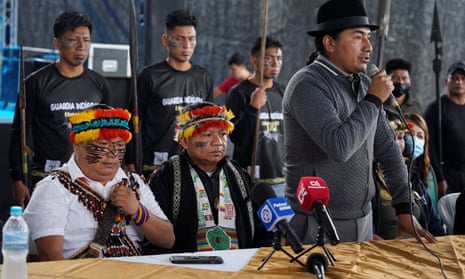Paris climate agreement goals will fail unless the rights of Indigenous people who protect rainforests are honoured, according to a new report.
Forest lands stewarded by Indigenous people and communities in countries such as Brazil, Colombia, Mexico and Peru sequester about twice as much carbon as other lands, according to the analysis.
To meet national climate goals – known as NDCs – without protecting this land would require draconian and abrupt lifestyle changes in forested countries.
Peru would have to take all vehicles off the roads to compensate for losing just half of the carbon sinks protected by Indigenous and community-held forests, says the study by the World Resources Institute (WRI) and Climate Focus. Brazil and Colombia would have to retire 80% of their vehicles to compensate for the increase in net emissions.
Juan-Carlos Altamirano, a senior economist at the WRI, who co-authored the paper, said: “It would be impossible for these countries to attain the NDC objectives if Indigenous rights are not protected and these lands are deforested or put to other uses. But in other parts of the world, it would likely be the same case.”
If the rights of Indigenous people and forest communities were not protected, the “most likely hypothesis” would be a failure to achieve the Paris climate goal of keeping global temperature rises below 1.5C, he said.
Indigenous people are by far the best rainforest custodians, with deforestation rates on their lands up to 50% lower than elsewhere, according to a UN study last year.
While an estimated 10% of the south-east Amazon appears to have already become a net carbon source owing to forest degradation, the WRI says that at least 92% of forested lands held by Indigenous peoples and communities in Amazonian countries are still carbon sinks. On average, these lands sequester more than 30 tons of carbon dioxide equivalent a hectare, more than twice as much as other lands.
In Brazil, however, the Jair Bolsonaro government has undermined Indigenous people’s protection agencies and fast-tracked legislation to open their lands to mining, oil and gas exploration, hydroelectric dams and soy plantations. Brazil’s deforestation rate soared by 57% last year to the highest level in a decade.
Izabella Teixeira, a former Brazilian environment minister honoured by the UN for helping to reverse Amazonian deforestation, said Bolsonaro offered only “a fake green, short-term perspective”, aimed at fooling the international community.
“Be sure: the interest of the Brazilian government today is not to address climate change or environmental damage,” she said. “Indigenous people have [constitutional] rights and the state should protect Indigenous people, and what has happened today is not this,” she said. “Indigenous people and environmental constituencies are being seen as part of the problem.”
To maximise the scope for Indigenous land protection, the WRI study calls for equivalent land ownership rights, legal recognition of Indigenous territories and community rights to free, prior and informed consent over forest projects.
The study was compiled by using satellite data to identify the carbon content, emissions and sequestration on land inhabited by Indigenous people and local communities. These were then compared with the four Latin American countries’ NDCs [nationally determined contributions] to the Paris climate agreement to see if they were included in policy planning.
“In most cases they were not,” Altamirano said.
